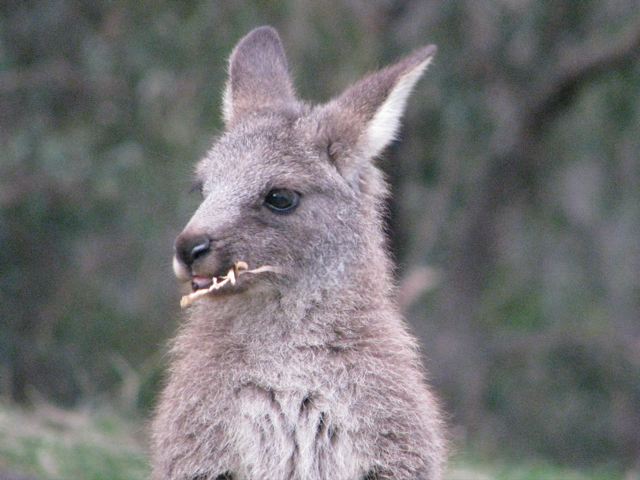Kangaroos
cannot be farmed. They cannot be herded or driven into yards or
abattoirs because they get too stressed (capture myopathy) and the
lactic acid builds up in their muscles causing the meat to go rancid
and become inedible. Nor can they be transported live unless the
appropriate techniques and medications are used.
Being
slaughtered in the field presents health and financial problems. The
farmer would need transportable chillers to send to the processors,
plus the animals would need to be inspected in the field prior to
slaughter to ensure the meat was healthy.
Kangaroos eat native
vegetation (not wheat) and it would take many years to grow back native
plants. They also need a lot of space to roam and cannot be confined in
overcrowded areas. Kangaroo-proof fencing is very expensive (DPI
recommends 12 wires alternately electrified, 2.13 metres high).
Then
there is the question of ownership. Under the Constitution all wildlife
is ‘owned’ by the Crown and therefore cannot be privately
‘owned,’ although farmers can own land and wildlife
habitat. And even if they could be owned, tagging kangaroos would
require expensive and risky tranquilisation. Branding them would kill
many or cause myopathy, again making the meat inedible.
Kangaroos
are small animals. An adult yields 6.9 kg of meat, only 0.25 kg of
which
would be human grade. Current annual kangaroo meat production
is
600 tonnes (from 2.5 million kangaroos) compared to 1,7000,000 tonnes
of beef. In order to produce enough meat to replace beef the entire
kangaroo population would have to be killed 566 times every year.
Kangaroos
breed from 2-3 years of age and only produce one joey a year. Survival
rate for joeys is low, especially during a drought. Sheep breed from 1
year of age and can produce twins. Joeys are dependent on their mothers
for 14 months (sheep for only a few months) and so cannot be
transported or sold as live young. Sheep produce meat, skin and wool -
kangaroos produce only meat and skin. A 10 year old adult male red
kangaroo weighing 60 kg can only produce 6 kg of prime cut meat. Lambs
can be slaughtered at 3-6 months of age to produce 20 kg meat (Preuss,
1999) and a 2 year old cow can produce 200 kg of meat.
Clearly kangaroo farming is not economically viable.
The
Department of the Environment talks about the ‘sustainable
harvesting of renewable resources.’ However their figures
show that in most of the states where kangaroos are hunted they are at
‘quasi-extinction’ levels, which, according to the Murray
Darling Report, is defined as less than 5 kangaroos per square
kilometre. Not only that, the kangaroo industry has killed off the
biggest males leaving mainly juveniles. The average age of kangaroos
shot is only 2-3 years i.e. barely at breeding age. In 2007 up to 80%
of the kangaroos killed in NSW were females. All of these factors are a
recipe for extinction. Why is the government failing to protect our
wildlife?
According to government websites kangaroo populations
have crashed up to 70% from 2001-2006, due mainly to the drought and
unrelenting pressure from the kangaroo industry which continues to set
unsustainably high quotas that are never met. In 2008 the quota is 3.7
million making this:-
We
are assured that kangaroos are humanely killed according to ‘the
code.’ However all the killing is performed from moving vehicles
in the bush at night, unsupervised, by shooters whose proficiency is
questionable. Many kangaroos are shot in the face or neck and left to
die painfully of starvation and gangrene. The adult females that are
killed often have an in-pouch joey and an at-foot joey.There is nothing
humane about the kangaroo killing industry.
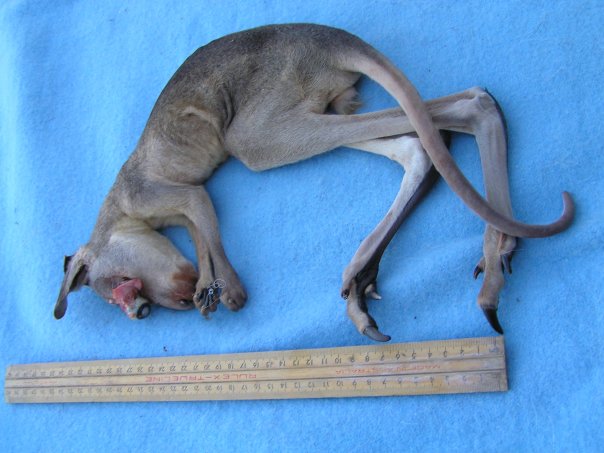
The in-pouch joey is either decapitated, stomped on or bashed to death
against a tree or truck.
The
at-foot joey flees to die of starvation, hypothermia or predation.
See
this cruelty at
http://tiny.cc/kanga or
here
(Warning: graphic content, adults only).
N.S.W.
has just opened up a zone around Mudgee under the FATE program allowing
farmers to share the profit with kangaroo shooters who target kangaroos
on their properties. The kangaroos may have been shot by the farmers
anyway, but shooters will shoot more because they are profit driven and
because kangaroos are basically shot out from the other areas, which is
why they have to keep on opening up new areas. In that program
approximately 25,000 joeys will be killed in the above manner every
single year until there are none left, which won't be long because they
will be killed faster than what they can breed.
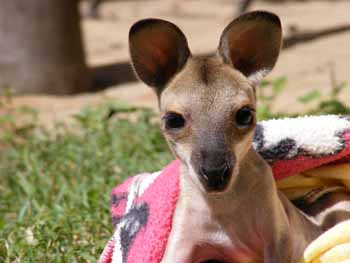
This
beautiful joey's mother was killed in a car accident. The wildlife
carers in the Mudgee area who are already overburdened with the care of
orphaned young like the one on the left must now deal with more joeys
orphaned thanks to the FATE program.
See
video
of distressed wildlife carer John 'Kangaroo Man' Lyle and his wife
Sandra with their joeys in care at Mudgee.
The
RSPCA, who knows nothing about wildlife, approves of this
program
as 'humane'. So much for 'All Creatures Great and Small.'
Are Kangaroos the Enemy or Do
They Benefit the Land?
It’s
true that European farming of livestock has wreaked havoc on our
environment. Livestock cause soil erosion and destroy soil ecosystems
by compacting the soil with hard hooves, thereby causing deserts. They
destroy forests and wildlife habitat because grazing land has to be
continuously created.
The methane and nitrous oxide from their
belching/farting/manure (especially dairy cows) leads to the creation
of massive amounts of greenhouse gas (more than the entire transport
sector). Over half the water used for all purposes is required by the
livestock industry. This is the worst drought in 100 years and water
should be used for crops to feed people, not livestock.
Cows
poop 100 times more than people so their massive amounts of manure
pollute water (ground and surface) and cause dead zones in the oceans.
Since up to 80% of all grains in the world are used to fatten livestock
instead of feeding hungry people, livestock farming contributes to
world hunger. Likewise 20 million Australians eating cows and sheep is
not sustainable or healthy for our country.
In fact kangaroos benefit the ecosystem and they do this in many ways:
1.
Kangaroos lessen the possibility of bushfires by eating dry grass that
ignites easily and in locations near trees that sheep and cattle cannot
reach (by virtue of being fenced in).
2. Kangaroos' soft padded
feet and long tail are integral to the ecological health of the land,
as regenerators of native grasses. Any seedling that falls into the
long-tapering footprint of the kangaroo is buried into the hole left by
the toenail. Covered and with moisture concentrated at one point, the
germinating seedling has a chance of survival. Their tail drags along
behind them while they are grazing, pressing the ground, rolling seeds
into the earth.
3. Kangaroos play an undeniable role in
biological diversity and ecological integrity by virtue of the fact
that they have lived in Australia for at least 16 million years, in
harmony with the other species as per the law of interdependence.
4.
Kangaroo urine and faeces is a natural fertilizer essential to the
health of the soil. Many species depend on the kangaroo for this
reason. Their waste is not high in nitrogen like livestock waste which
seriously pollutes ground and surface water. (Reference:
http://milk.procon.org/viewanswers.asp?questionID=001056 )
5. Unlike the livestock industry, Kangaroos do not degrade the
environment by:
a)
producing virtually no methane greenhouse gases through exhaling and
eructation. The hydrogen by product of fermentation is instead
converted into acetate, which is then used to provide further energy.
The greenhouse gas effect of methane is 23 times greater than that of
carbon dioxide. However, the greenhouse gases from the livestock
industry is 18% total emissions (which exceeds the entire transport
sector at 14%).
b) requiring massive quantities of water as with
cows. Kangaroos have slender noses with a long narrow tongue that can
lap water from sources that broad nosed livestock cannot even get to or
would find unacceptable. (Reference: David Croft, p.238-9, Kangaroo
Myths and Realities).
c) causing soil erosion, loss of soil
nutrients and soil ecosystems leading to soil desertification.
Kangaroos are not hoofed animals (like livestock) that compact the soil
and cause soil problems.
d) destroying wildlife (the livestock industry shoots native animals
which it regards as pests)
e) destroying trees or habitat of other species
f) contributing to the eutrophication and acidification of water and
the ocean.
g) excessive grazing. Kangaroos' grazing pressure is only 1-8%
ref:http://www.environment.gov.au/soe/2006/publications/drs/indicator/162/index.html
The rest of the grazing pressure is mainly cows and sheep.
(References
for all the above environmental effects of the livestock industry:
http://www.fao.org/newsroom/en/news/2006/1000448/index.html )
Kangaroos
have intrinsic value and are perfectly adapted to their environment.
The more kangaroos, the more biodiversity in Australia. However
governments are now claiming that kangaroos overgraze or threaten
endangered species, even though there are no published articles in peer
reviewed journals proving this scientifically.
Photo
by Stella Reid, Wildhaven
A
recent report commissioned by Maxine Cooper, Commissioner for
Sustainability and the Environment says that kangaroos protect us
against CLIMATE CHANGE and its effects, by minimising bush fires and
helping to regenerate the flora along with other species at risk. Read
the fascinating report
here
written by the Canberra Environment and Sustainability Resource Centre.
In spite of the scientifical qualifications of the author, it's
interesting to note that this report was rejected by Cooper. Could it
be too incriminating that 9,000 of these wonderfully
environmentally-friendly creatures were needlessly destroyed at Majura
earlier this year by the A.C.T. government on the unsubstantiated
grounds that they were 'overgrazing' and 'overpopulated'?
What Else Can we Eat if
not Kangaroo Meat?
Clearly,
farming kangaroos is NOT the solution; countless wild species depend on
kangaroos’ presence in the bush. The solution to the
environmental pollution caused by the livestock industry is staring us
in the face. For more info visit
here.
| "Nothing
will benefit human health or increase the chances for survival on Earth
as will the evolution to a vegetarian diet" - Albert Einstein |
Is Our Tourism Industry at risk?
A
$200 million a year kangaroo industry is not going to shut down because
people and pets are dying, Australia’s $85 billion tourist
industry is being jeopardised or kangaroos are heading towards
extinction. As long as there is money to be made and people to be paid
off, this ugly business will continue. Read about the kangaroo industry
at www.smuggled.com/vac.htm
Don’t kill the goose that
lays the golden egg! The kangaroo is the spirit of Australia, and is
our great national icon. Let’s support nature-based eco-tourism
at
http://www.rootourism.com.au
Is Australia's National Icon on
Track to Extinction?
Hard to believe? See the shocking facts from government sources
at this
website.
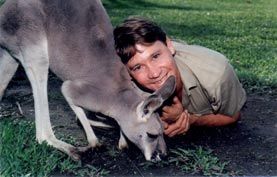
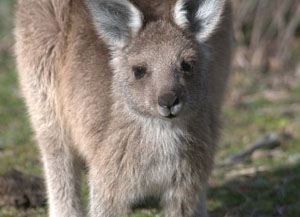


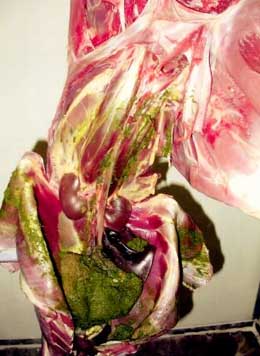 Toxoplasmosis
outbreaks related to kangaroo meat consumption are well known and have
resulted in deaths and multiple illnesses. In 2008 three kangaroo
processing plants closed down and Russia has rejected imports due to
e.coli
contamination. Canada, among other countries, has banned the
importation of kangaroo meat. Additionally, eating kangaroo meat can
cause anaphylaxis (an allergic reaction) and also bowel cancer, as its
iron content is twice that of beef (high dietary iron being a risk
factor for bowel cancer).
Toxoplasmosis
outbreaks related to kangaroo meat consumption are well known and have
resulted in deaths and multiple illnesses. In 2008 three kangaroo
processing plants closed down and Russia has rejected imports due to
e.coli
contamination. Canada, among other countries, has banned the
importation of kangaroo meat. Additionally, eating kangaroo meat can
cause anaphylaxis (an allergic reaction) and also bowel cancer, as its
iron content is twice that of beef (high dietary iron being a risk
factor for bowel cancer).
 This
beautiful joey's mother was killed in a car accident. The wildlife
carers in the Mudgee area who are already overburdened with the care of
orphaned young like the one on the left must now deal with more joeys
orphaned thanks to the FATE program.
This
beautiful joey's mother was killed in a car accident. The wildlife
carers in the Mudgee area who are already overburdened with the care of
orphaned young like the one on the left must now deal with more joeys
orphaned thanks to the FATE program. 